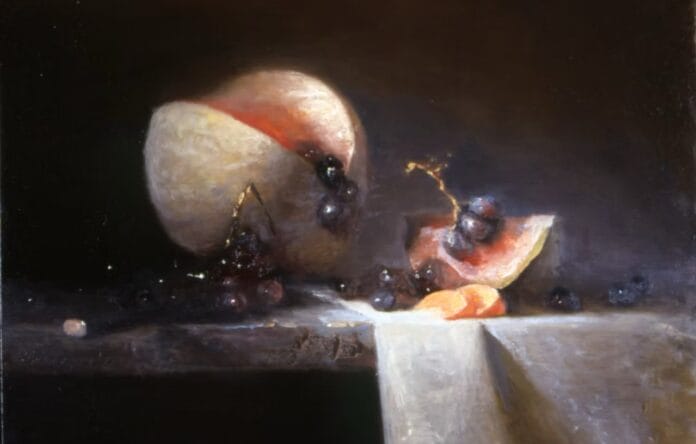M Kathryn Massey is an accomplished American painter whose work invites viewers not to glance, but to look and not to look merely for beauty, but for meaning. Through stillness, precision, and a philosophical engagement with ordinary objects, she creates paintings that reveal a deeper layer of reality. Massey calls this layer transcendence, and she has spent decades developing a body of work that consistently reaches toward it.
Artist’s Biography
M Kathryn Massey (b. 1953) is a Signature Member of both the Oil Painters of America (OPA) and Audubon Artists, achievements earned through rigorous juried review. Over her expansive career, she has held or continues to hold affiliations with several esteemed institutions, including the American Academy of Women Artists, American Artists Professional League, Allied Artists of America, and the Hoosier Salon. These memberships reflect not only her technical excellence but also her commitment to the advancement of representational art in America.
Currently residing along the dramatic Northern California coastline, Massey’s surroundings offer both inspiration and solitude elements that resonate deeply in her work. The Pacific light, with its shifting greys and muted tones, appears to echo in her paintings, where light is never just illumination but a narrative element of its own.
Beyond Literalism: A Philosophy of Transcendence
At the heart of Massey’s work is a compelling artistic philosophy she calls Beyond Literalism. For Massey, painting is more than representation; it is revelation. She describes her role as an Agent, bringing together ordinary objects with the principles of art to reveal the hidden radiance of everyday things.
This viewpoint situates her within a tradition of artists who seek to make the invisible visible not through abstraction but through a disciplined attention to form, color, light, and composition. Her use of the term transcendence does not refer to something esoteric or unreachable, but to a lived experience of presence and quiet awe. That transcendence, Massey emphasizes, cannot be forced. It emerges only when the artist’s intentions are aligned with the work’s integrity, when the hand, the eye, and the spirit are unified.
In a contemporary culture often fixated on immediacy and bold statements, Massey’s reverence for the subtle and the sincere stands apart. Her work reminds us that the profound can be found not only in the monumental but also in a melon, a bunch of grapes, or a bowl of peaches.
The Integrity of the Artist
Integral to Massey’s concept of transcendence is the integrity of the painter. Technique alone is not enough. The painter must bring to the canvas not just skill but intention, a word that Massey uses carefully. Intention, in her framework, is the inward compass of the artist, guiding decisions about composition, tone, and texture. It is what gives a painting its spiritual weight, what turns a well-rendered still life into a window onto something more.
For viewers, this means encountering art that feels quiet yet resonant, refined yet soulful. Her paintings resist narrative in the traditional sense, yet they tell a story all the same, a story about our relationship to objects, to time, and to perception itself.
A Closer Look: Melon with Grapes
One of the most striking examples of Massey’s philosophy in action is her oil painting titled Melon with Grapes. At first glance, the piece appears as a finely executed still life, a testament to her command of classical oil techniques. The lighting is soft yet deliberate, the surface textures exquisitely rendered. But to stop there would be to miss the point.
In Melon with Grapes, Massey’s intention quietly asserts itself. The melon’s fleshy ripeness and the grapes’ subtle translucence are not merely botanical studies; they are vessels of meaning. The fruit is not symbolic in a literary sense, but sacramental in its presentation. It feels elevated. Massey achieves this not by altering the subject matter but by intensifying the viewer’s attention to its form and being.
This is where her concept of transcendence takes hold: the ordinary becomes extraordinary not through transformation, but through revelation. The hidden radiance emerges, and we as viewers are not just observers, we are participants in a contemplative act.
The Artist as Agent
Massey’s self-characterization as an Agent is worth considering further. It suggests a humility before the work, a recognition that art is not about control, but about collaboration between the artist and the medium, between intention and accident, and ultimately between the artist and the viewer.
Her approach recalls the philosophies of the old masters, who viewed painting not as self-expression but as a form of service to the subject, to the viewer, and to truth. Massey reanimates that lineage for our time. In doing so, she offers an alternative model for what contemporary painting can be, not reactive or ironic, but rooted, meditative, and sincere.
Conclusion: The Enduring Power of Seeing
M Kathryn Massey’s paintings offer a form of resistance and a form of refuge. Her work reminds us that the act of seeing can be profound, that stillness has power, and that even the most familiar objects can carry within them a hidden radiance waiting to be revealed.
Through her disciplined practice and deep commitment to artistic integrity, Massey invites us to look again to move beyond literalism and into the transcendent. Her paintings are not loud, but they are unforgettable. They stay with us, quietly insisting that beauty, meaning, and mystery are not far away. They are right in front of us, if only we have the eyes and the heart to see.


